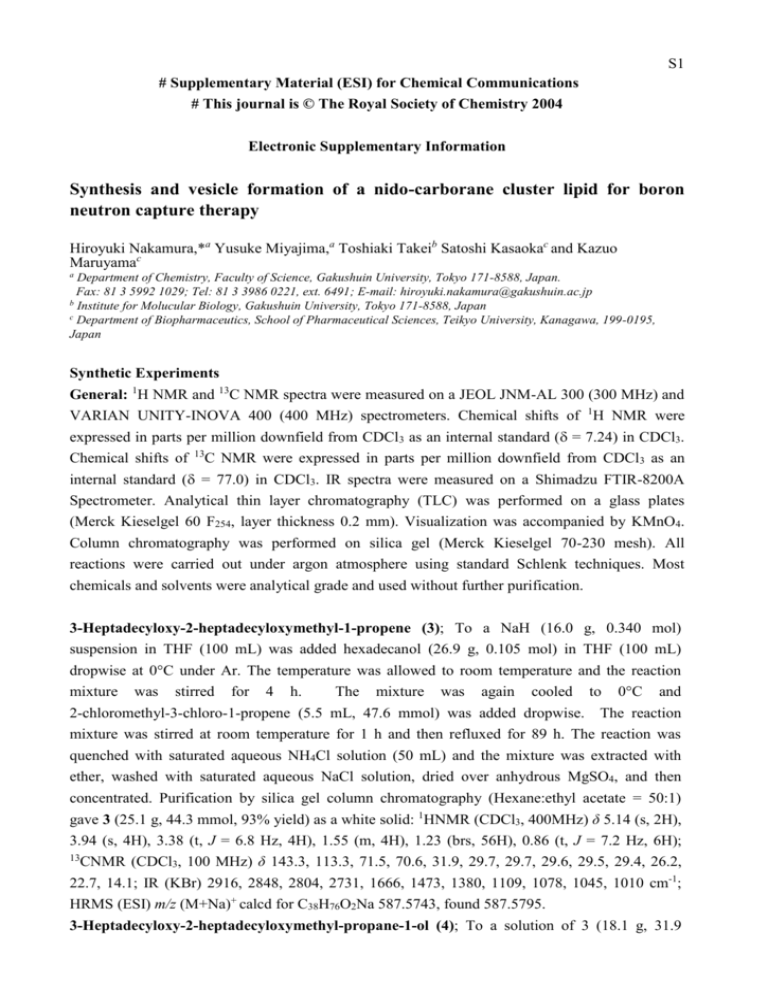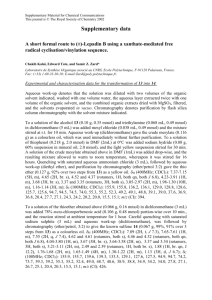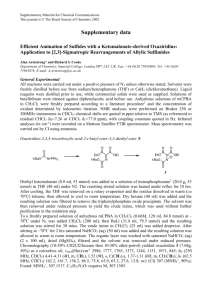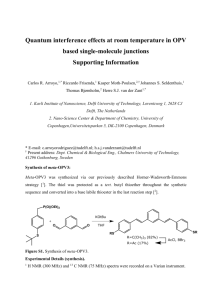Experimental procedures and spectral data for the compounds 2-6
advertisement

S1 # Supplementary Material (ESI) for Chemical Communications # This journal is © The Royal Society of Chemistry 2004 Electronic Supplementary Information Synthesis and vesicle formation of a nido-carborane cluster lipid for boron neutron capture therapy Hiroyuki Nakamura,*a Yusuke Miyajima,a Toshiaki Takeib Satoshi Kasaokac and Kazuo Maruyamac a Department of Chemistry, Faculty of Science, Gakushuin University, Tokyo 171-8588, Japan. Fax: 81 3 5992 1029; Tel: 81 3 3986 0221, ext. 6491; E-mail: hiroyuki.nakamura@gakushuin.ac.jp b Institute for Molucular Biology, Gakushuin University, Tokyo 171-8588, Japan c Department of Biopharmaceutics, School of Pharmaceutical Sciences, Teikyo University, Kanagawa, 199-0195, Japan Synthetic Experiments General: 1H NMR and 13C NMR spectra were measured on a JEOL JNM-AL 300 (300 MHz) and VARIAN UNITY-INOVA 400 (400 MHz) spectrometers. Chemical shifts of 1H NMR were expressed in parts per million downfield from CDCl3 as an internal standard ( = 7.24) in CDCl3. Chemical shifts of 13C NMR were expressed in parts per million downfield from CDCl3 as an internal standard ( = 77.0) in CDCl3. IR spectra were measured on a Shimadzu FTIR-8200A Spectrometer. Analytical thin layer chromatography (TLC) was performed on a glass plates (Merck Kieselgel 60 F254, layer thickness 0.2 mm). Visualization was accompanied by KMnO4. Column chromatography was performed on silica gel (Merck Kieselgel 70-230 mesh). All reactions were carried out under argon atmosphere using standard Schlenk techniques. Most chemicals and solvents were analytical grade and used without further purification. 3-Heptadecyloxy-2-heptadecyloxymethyl-1-propene (3); To a NaH (16.0 g, 0.340 mol) suspension in THF (100 mL) was added hexadecanol (26.9 g, 0.105 mol) in THF (100 mL) dropwise at 0°C under Ar. The temperature was allowed to room temperature and the reaction mixture was stirred for 4 h. The mixture was again cooled to 0°C and 2-chloromethyl-3-chloro-1-propene (5.5 mL, 47.6 mmol) was added dropwise. The reaction mixture was stirred at room temperature for 1 h and then refluxed for 89 h. The reaction was quenched with saturated aqueous NH4Cl solution (50 mL) and the mixture was extracted with ether, washed with saturated aqueous NaCl solution, dried over anhydrous MgSO4, and then concentrated. Purification by silica gel column chromatography (Hexane:ethyl acetate = 50:1) gave 3 (25.1 g, 44.3 mmol, 93% yield) as a white solid: 1HNMR (CDCl3, 400MHz) δ 5.14 (s, 2H), 3.94 (s, 4H), 3.38 (t, J = 6.8 Hz, 4H), 1.55 (m, 4H), 1.23 (brs, 56H), 0.86 (t, J = 7.2 Hz, 6H); 13 CNMR (CDCl3, 100 MHz) δ 143.3, 113.3, 71.5, 70.6, 31.9, 29.7, 29.7, 29.6, 29.5, 29.4, 26.2, 22.7, 14.1; IR (KBr) 2916, 2848, 2804, 2731, 1666, 1473, 1380, 1109, 1078, 1045, 1010 cm-1; HRMS (ESI) m/z (M+Na)+ calcd for C38H76O2Na 587.5743, found 587.5795. 3-Heptadecyloxy-2-heptadecyloxymethyl-propane-1-ol (4); To a solution of 3 (18.1 g, 31.9 S2 mmol) in THF (300 mL) was added BH3・Me2S (31.9 mmol) dropwise at 0°C under Ar. The temperature was allowed to room temperature and the reaction mixture was stirred for 6 h. The mixture was again cooled to 0°C and an aqueous NaOH solution (3 M, 100 mL) was added. The reaction mixture was stirred at0°C for 24 h and then H2O2 (30%, 100 mL) was added. After 12 h at room temperature with stirring, K2CO3 (5g) was added and the mixture was extracted with ether, washed with saturated aqueous NaCl solution, dried over anhydrous MgSO4, and then concentrated. The residue was passed through short column chromatography on SiO2 with hexane/ethyl acetate (30/1) and then recrystalization from hexane gave 4 (13.3 g, 22.8 mmol, 71% yield) as a colorless crystal:1HNMR (CDCl3, 400MHz) δ 3.74 (t, J = 5.2 Hz, 2H), 3.50 (m, 4H), 3.38 (t, J = 5.2 Hz, 4H), 2.07 (quint, J = 5.6 Hz, 1H), 1.53 (t, J = 6.4 Hz, 4H), 1.23 (brs, 56H), 0.86 (t, J = 6.8 Hz, 6H); 13CNMR (CDCl3, 100 MHz) δ 71.8, 71.2, 65.1, 41.4, 32.1, 29.9, 29.8, 29.7, 29.6, 26.3, 22.9, 14.3; IR (KBr) 3328, 2839, 2744, 1471, 1377, 1313, 1232, 1213, 1191, 1116, 1041 cm-1; HRMS (ESI) m/z (M+Na)+ calcd for C38H78O3Na 605.5848, found 605.5816. 3-Heptadecyloxy-2-heptadecyloxymethyl-1-propargyloxypropane (5); To a NaH (1.03 g, 25.7 mmol) suspension in THF (20 mL) was added 4 (3.0 g, 5.2 mmol) in THF (15 mL) dropwise at 0°C under Ar. The temperature was allowed to room temperature and the reaction mixture was stirred for 3 h. The mixture was again cooled to 0°C and propargyl bromide (1.6 mL, 15.4 mmol) was added dropwise. The reaction mixture was stirred at room temperature for 20 h. The reaction was quenched with saturated aqueous NH4Cl solution (20 mL) and the mixture was extracted with ether, washed with saturated aqueous NaCl solution, dried over anhydrous MgSO4, and then concentrated. Purification by silica gel column chromatography (Hexane:ethyl acetate = 30:1) gave 5 (1.87 g, 3.0 mmol, 58% yield) as a yellow solid: 1HNMR (CDCl3, 400MHz) δ 4.41 (d, J = 2.4 Hz, 2H), 3.55 (d, J = 6.0 Hz, 2H), 3.43 (d, J = 6.4 Hz, 4H), 3.38 (t, J = 6.4 Hz, 4H), 2.39 (s, 1H), 2.14 (m, 1H), 1.52 (t, J = 6.8 Hz, 4H), 1.24 (brs, 56H), 0.87 (t, J = 6.8 Hz, 6H); 13 CNMR (CDCl3, 100 MHz) δ 74.2, 71.4, 69.2, 69.0, 58.6, 40.4, 32.1, 29.9, 29.8, 29.7, 29.6, 26.4, 22.9, 14.3; IR (KBr) 3249, 2912, 2848, 2798, 1508, 1473, 1458, 1359, 1087 cm-1; HRMS (ESI) m/z (M+Na)+ calcd for C41H80O3Na 643.6005, found 643.5989. (3-Heptadecyloxy-2-heptadecyloxymethyl-1-propoxy)methyl-ortho-carborane (6); The mixture of 5 (0.61 g, 0.99 mmol), decaborane (0.15 g, 1.2 mmol), and acetonitrile (1.56 mL, 29.6 mmol) in toluene (20 mL) was stirred under reflux condition for 6 h. The solvent was removed under the reduced pressure and the residue was purified by silica gel column chromatography (Hexane:ethyl acetate = 30:1) to give 6 (0.61 g, 0.83 mmol, 80% yield) as a white solid: 1HNMR (CDCl3, 400MHz) δ 3.97 (brs, 1H), 3.51 (d, J = 5.6 Hz, 2H), 3.40-1.40 (m, 10H), 2.09 (quint, J = 6.0 Hz, 1H), 1.51 (t, J = 6.8 Hz, 4H), 1.24 (brs, 56H), 0.86 (t, J = 6.8 Hz, 6H); 13CNMR (CDCl3, 100 MHz) δ 72.3, 71.6, 70.4, 68.9, 57.7, 40.4, 32.1, 29.9, 29.8, 29.7, 29.6, 26.4, 22.9, 14.3; IR (KBr) 2918, 2850, 2572, 1465, 1377, 1112, 1095,1012 cm-1; MS (MALDI) m/z (M+Na)+ C41H90O3B10Na 763.8. (3-Heptadecyloxy-2-heptadecyloxymethyl-1-propoxy)methyl-ortho-nido-carborane sodium salt (2); The mixture of 6 (0.92 g, 1.25 mmol), and NaOMe (0.68 g, 12.5 mmol) in MeOH (15 mL) was stirred under reflux condition for 14 h. The reaction mixture was diluted with water (20 S3 mL), extracted with ethyl acetate, washed with saturated aqueous NaCl solution, dried over anhydrous MgSO4, and then concentrated. Purification by silica gel column chromatography (gradient from hexane:ethyl acetate = 30:1 to ethyl acetate only) gave 2 (0.56 g, 0.72 mmol, 57% yield) as a white solid: 1HNMR (CDCl3, 400MHz) δ 3.77(d, J = 5.6 Hz, 2H), 3.52 (m, 6H), 3.40 (t, J = 6.4 Hz, 4H), 2.09 (m, 1H), 1.54 (m, 4H), 1.24 (brs, 56H), 0.87 (t, J = 6.8 Hz, 6H); 13CNMR (CDCl3, 100 MHz) δ41.05, 32.31, 29.93, 29.87, 29.57, 26.02, 22.90, 14.32; IR (KBr) 3419, 3251, 2850, 2520, 1714, 1614, 1456, 1373 cm-1; MS (MALDI) m/z (M+Na)+ C41H89O3B9Na2 774.8. Transmission Electron Microscopy Experiment An aliquot of the sample solution was applied to electron microscope carbon-coated grids covered with parlodion backing. The excess of the solution was blotted with filter paper. Grids were immediately negatively stained with 2.5% uranyl acetate for 10 min and washed with buffer A. The grids were examined in a Transmission Electron Microscope (JEOL 100c) at an accelerating voltage of 80 kV. Preparation of liposomes General: DSPC (distearolyphosphatidylcholine; COATSOME MC-8080), DSPE (distearoylphosphatidylethanolamine; COATSOME ME-8080), monomethoxy polyethyleneglycol succinimidyl succinate (PEG-OSu) were kindly donated by Nippon Oil and Fats Co. (Tokyo, Japan). The values of the number-average molecular weight of PEG-OSu and PEG-2OSu were 2219 and 3230, respectively, and their polydispersities were 1.03 and 1.04, respectively, as measured by means of gel permeation chromatography. CH (cholesterol) and triethylamine were purchased from Wako Pure Chemicals (Osaka, Japan). Preparation of the boron cluster liposomes Bare liposomes were prepared from DSPC, CH and boron-cluster lipid 2 (1:1:X, X=0~1, molar ratio). PEG-liposomes were prepared from DSPC, CH, boron-cluster lipid 2 and PEG-DSPE (1:1:X:0.11, X=0~1, molar ratio). Small unilamellar vesicles (SUV) of these liposomes were prepared according to the reverse-phase evaporated vesicle (REV) method.[1] Lipids were dissolved in a chloroform/diethyl ether mixture (1:1 v/v). The volume ratio of aqueous phase to organic phase was maintained at 1:4. The emulsion was sonicated for 1 min and then reduced to a gel by evaporation in a rotary evaporator at 60°C under vacuum for 1 h. The gel obtained was subjected to extusion through a polycarbonate membrane of 100 nm pore size, using an extruder device (Lipex Biomembranes Inc., Canada) thermostated at 60°C in order to obtain liposomes with a homogeneus size distribution. The lipid concentration was estimated by phosphorus assay.[2] Liposome size was measured with an electrophoretic light scattering spectrophotometer (ELS-700, Otsuka Electroics, Tokyo). Boron content was determined by ICP-AES. References 1. Szoka, F., and Papahadjopoulos, D. Procedure for preparation of liposomes with large internal aqueous space and high capture by reverse-phase evaporation. Proc. Natl. Acad. Sci. USA, 75: S4 4194-4198, (1978). 2. Fiske, C.H., and Subbarow, Y. The colorimetric determination of phosphorus. J. Biol. Chem., 66:375-400, (1925).







